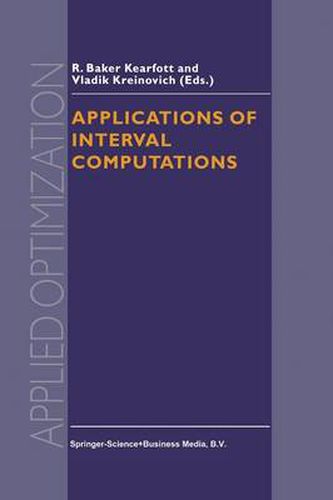Readings Newsletter
Become a Readings Member to make your shopping experience even easier.
Sign in or sign up for free!
You’re not far away from qualifying for FREE standard shipping within Australia
You’ve qualified for FREE standard shipping within Australia
The cart is loading…






This title is printed to order. This book may have been self-published. If so, we cannot guarantee the quality of the content. In the main most books will have gone through the editing process however some may not. We therefore suggest that you be aware of this before ordering this book. If in doubt check either the author or publisher’s details as we are unable to accept any returns unless they are faulty. Please contact us if you have any questions.
Primary Audience for the Book * Specialists in numerical computations who are interested in algorithms with automatic result verification. * Engineers, scientists, and practitioners who desire results with automatic verification and who would therefore benefit from the experience of suc cessful applications. * Students in applied mathematics and computer science who want to learn these methods. Goal Of the Book This book contains surveys of applications of interval computations, i. e. , appli cations of numerical methods with automatic result verification, that were pre sented at an international workshop on the subject in EI Paso, Texas, February 23-25, 1995. The purpose of this book is to disseminate detailed and surveyed information about existing and potential applications of this new growing field. Brief Description of the Papers At the most fundamental level, interval arithmetic operations work with sets: The result of a single arithmetic operation is the set of all possible results as the operands range over the domain. For example, [0. 9,1. 1] + [2. 9,3. 1] = [3. 8,4. 2], where [3. 8,4. 2] = {x + ylx E [0. 9,1. 1] and y E [3. 8,4. 2]}. The power of interval arithmetic comes from the fact that (i) the elementary operations and standard functions can be computed for intervals with formulas and subroutines; and (ii) directed roundings can be used, so that the images of these operations (e. g.
$9.00 standard shipping within Australia
FREE standard shipping within Australia for orders over $100.00
Express & International shipping calculated at checkout
This title is printed to order. This book may have been self-published. If so, we cannot guarantee the quality of the content. In the main most books will have gone through the editing process however some may not. We therefore suggest that you be aware of this before ordering this book. If in doubt check either the author or publisher’s details as we are unable to accept any returns unless they are faulty. Please contact us if you have any questions.
Primary Audience for the Book * Specialists in numerical computations who are interested in algorithms with automatic result verification. * Engineers, scientists, and practitioners who desire results with automatic verification and who would therefore benefit from the experience of suc cessful applications. * Students in applied mathematics and computer science who want to learn these methods. Goal Of the Book This book contains surveys of applications of interval computations, i. e. , appli cations of numerical methods with automatic result verification, that were pre sented at an international workshop on the subject in EI Paso, Texas, February 23-25, 1995. The purpose of this book is to disseminate detailed and surveyed information about existing and potential applications of this new growing field. Brief Description of the Papers At the most fundamental level, interval arithmetic operations work with sets: The result of a single arithmetic operation is the set of all possible results as the operands range over the domain. For example, [0. 9,1. 1] + [2. 9,3. 1] = [3. 8,4. 2], where [3. 8,4. 2] = {x + ylx E [0. 9,1. 1] and y E [3. 8,4. 2]}. The power of interval arithmetic comes from the fact that (i) the elementary operations and standard functions can be computed for intervals with formulas and subroutines; and (ii) directed roundings can be used, so that the images of these operations (e. g.